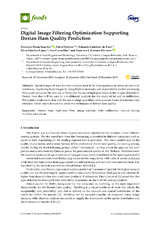| dc.contributor.author | Perán-Sánchez, Francisco | |
| dc.contributor.author | Serrano, Salud | |
| dc.contributor.author | Gutiérrez de Ravé Agüera, Eduardo | es_ES |
| dc.contributor.author | Sánchez-López, Elena | es_ES |
| dc.contributor.author | Cumplido, Ana | es_ES |
| dc.contributor.author | Jiménez-Hornero, Francisco José | es_ES |
| dc.date.accessioned | 2020-01-07T11:24:16Z | |
| dc.date.available | 2020-01-07T11:24:16Z | |
| dc.date.issued | 2020 | |
| dc.identifier.uri | http://hdl.handle.net/10396/19248 | |
| dc.description.abstract | Digital images of food for later analysis tend to be heterogeneous in terms of color and luminosity. Improving these images by using filters is necessary and crucial before further processing. This paper compares the non-use of filters and the use of high-pass filters in the images of hand-cut Iberian ham that will be used in a multifractal analysis for the study of fat and its infiltration. The yielded results show that with the use of a high-pass filter, more accurate fractal dimensions were obtained, which can be featured in predictive techniques of Iberian ham quality. | es_ES |
| dc.format.mimetype | application/pdf | es_ES |
| dc.language.iso | eng | es_ES |
| dc.publisher | MDPI | es_ES |
| dc.rights | https://creativecommons.org/licenses/by/4.0/ | es_ES |
| dc.source | Foods 9(1), 25 (2020) | es_ES |
| dc.subject | Iberian ham | es_ES |
| dc.subject | High-pass filter | es_ES |
| dc.subject | Image analysis | es_ES |
| dc.subject | Fatty infiltration | es_ES |
| dc.subject | Manual slicing | es_ES |
| dc.subject | Multifractal analysis | es_ES |
| dc.title | Digital Image Filtering Optimization Supporting Iberian Ham Quality Prediction | es_ES |
| dc.type | info:eu-repo/semantics/article | es_ES |
| dc.relation.publisherversion | http://dx.doi.org/10.3390/foods9010025 | es_ES |
| dc.rights.accessRights | info:eu-repo/semantics/openAccess | es_ES |

